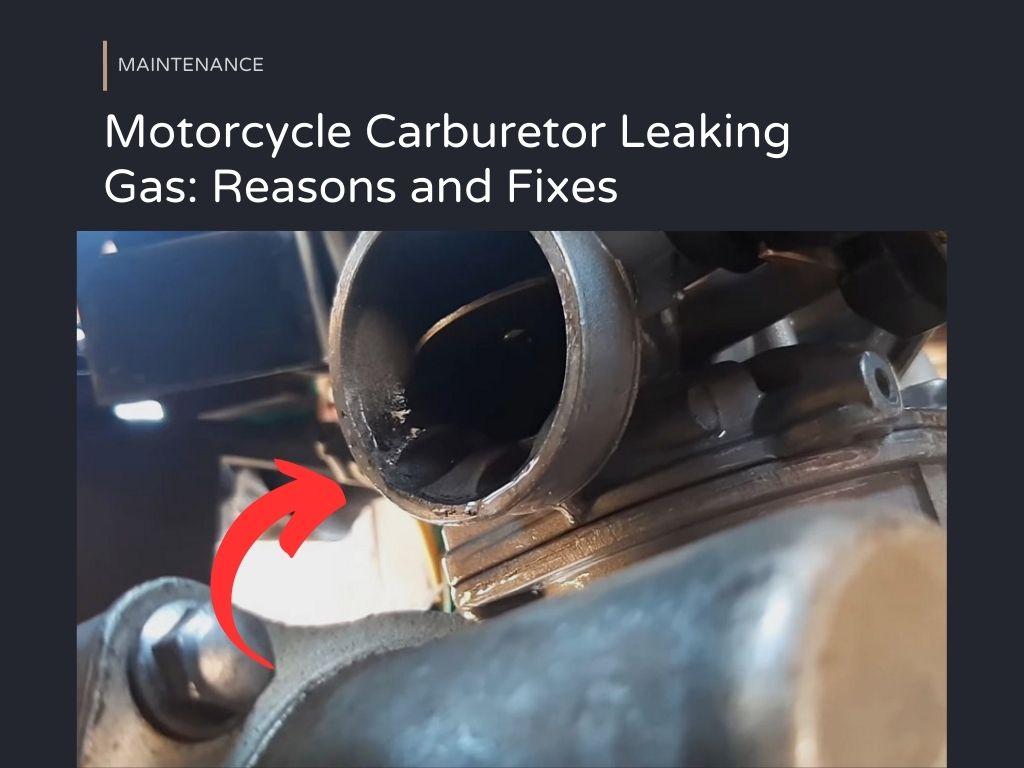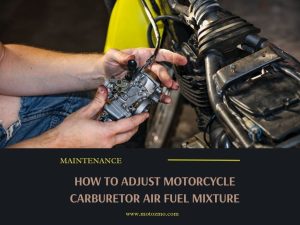🎯 Key Takeaways
- Common causes of carburetor leaks include loosened fuel petcock or needle valve, crack in the float bowl, and worn-out seal or gasket.
- Potential fixes for minor leaks include cleaning a fuel tank vent, fixing a stuck carburetor float, and tightening loose components.
- To help prevent leaks, keep your motorcycle clean and perform regular maintenance.
- For more significant leaks or if DIY fixes don’t work, contact a professional.
Finding a puddle of gas under your bike isn’t just frustrating, it’s dangerous. A carburetor leak not only threatens your wallet but may lead to engine damage, fire hazards, or fuel-soaked oil. Fortunately, with a structured approach, most causes can be diagnosed and fixed safely, often without needing a pro.
In this post, we’ll break down the common reasons behind a leaky motorcycle carb and guide you through simple fixes you can tackle yourself.
Diagnostic Flowchart of Motorcycle Carb Leaking Gas Issue
| Step | What to Do | Observe/Check |
|---|---|---|
| 1 | Turn off petcock, park bike upright | Does leak stop? |
| 2 | Inspect gas cap vent | Is there pressure or blockage causing fuel push? |
| 3 | Check fuel lines and clamps | Any obvious cracks or drips? |
| 4 | Tap the carb bowl gently | Does leak reduce, indicating stuck float? |
| 5 | Remove bowl to test float and needle seating | Use hand pump or clear tube; check proper sealing. |
| 6 | Measure float height using service manual specs | Overfill = high float setting |
| 7 | Inspect overflow & drain caps for cracks or loose parts | Especially on older Honda models |
| 8 | Reassemble, then test with engine running and hot, confirm fix | Still leaking? Back to step 4. Otherwise, it’s done. |
Motorcycle Leaking Carburetor Symptoms
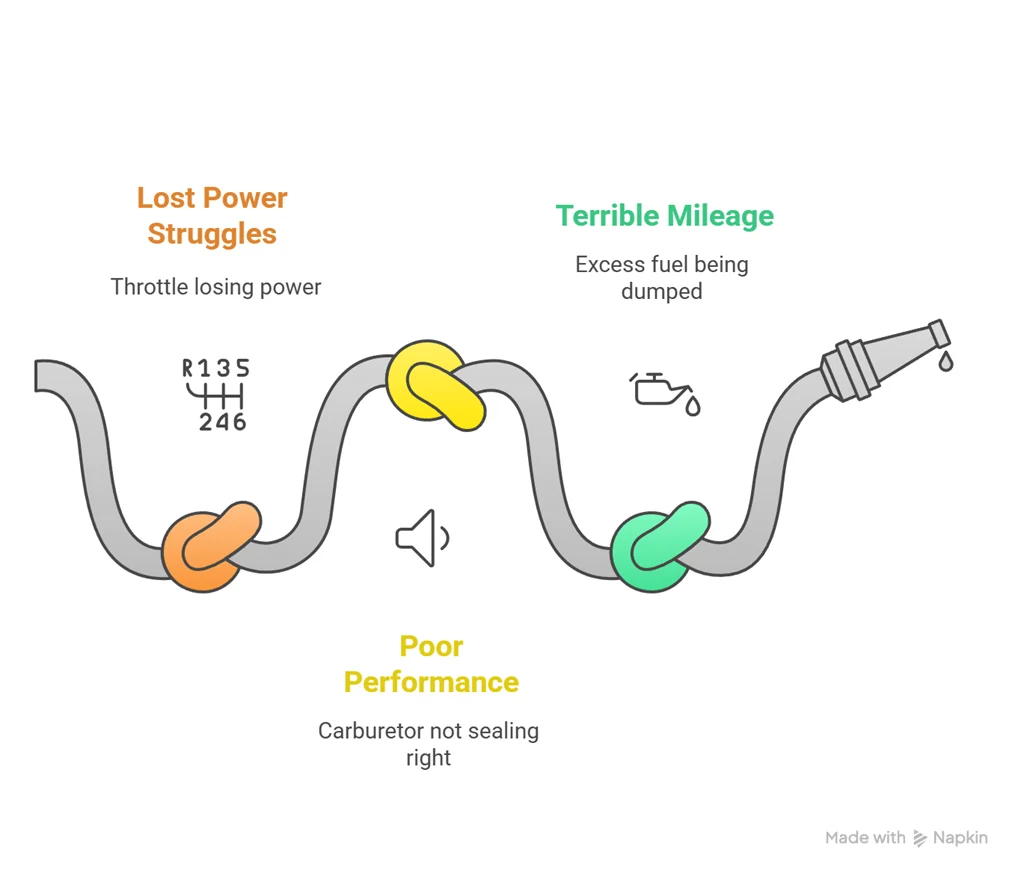
There are several signs that can clue you about the motorcycle carb leaking gas.
Issues like leaks or cracks can cause troubles like sluggish acceleration, bad fuel economy, and annoying hissing noises. Being familiar with these symptoms could help you address carb problems before they get worse.
a. Lost Power Struggles
One of the main signs is losing power when you twist the throttle. The carburetor isn’t getting enough air and fuel into the engine when you open it up.
This makes it real tough to speed up from a stop or merge into traffic. Vacuum leaks are usually the culprit, letting unmetered air into the system and throwing off the balance.
b. Poor Performance
Ever notice a hissing sound coming from under the gas tank? That air leak noise is your carb telling you it’s not sealing right.
Without a proper vacuum, the carb can’t do its job of mixing fuel and air. Time to inspect those rubber intake boots!
c. Terrible Mileage
If you’ve noticed your bike just isn’t stretching a tank of gas as far lately, carb problems could be to blame.
A leak means excess fuel is being dumped rather than burned. So you end up filling up a lot more than you should. A carb tune up should sort out the rich mixture and boost that fuel economy again.
Motorcycle Carb Leaking Gas: Reasons and Troubleshooting
So, why does this pesky problem happen?
It could be because a hose isn’t sealed, a gasket is worn, or a nut isn’t tight enough. And the most common places for leaks are at the fuel petcock, carburetor, and gas tank.
But before that, you should know a little about how the float and needle in a motorcycle work.
Inside the carb is a float chamber. Think of it like a tiny fuel tank. The float rises and falls with the fuel level. When it gets high enough, the float pushes the needle into the seat, stopping fuel from coming in.
If the needle or float doesn’t work right, fuel keeps coming even when the bowl is full. That extra fuel has to go somewhere, usually out the overflow.
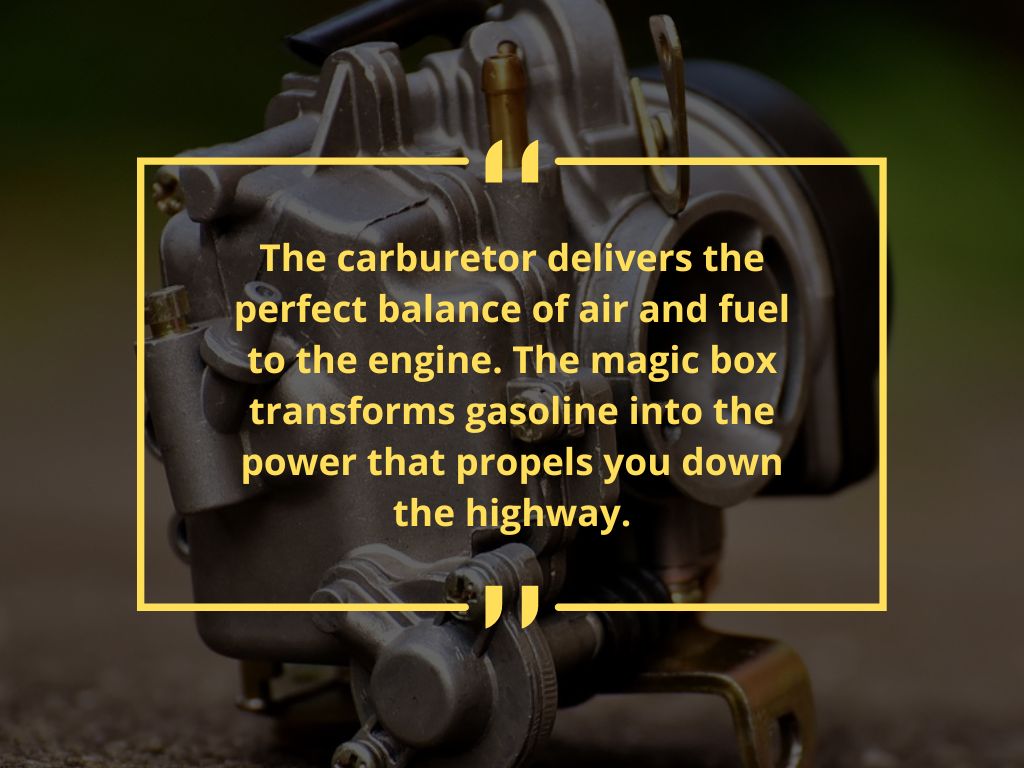
1. Fuel Tank Cap or Vent Blockage
The gas cap does more than just seal the tank. It has a vent that lets air in as fuel flows out.
If that vent gets blocked, pressure builds up inside the tank. That pressure pushes fuel into the carburetor and out through the overflow.
2. Petcock Valve Failure
The petcock is a valve that controls fuel flow from the tank to the carb. When it’s working, it stops fuel when the bike is off.
If it sticks open or leaks, gas keeps flowing even when the bike isn’t running. That can flood the carb and cause a leak.
3. Fuel Lines, Hoses, or Clamps
Old fuel lines can dry out and crack. Clamps can come loose. When that happens, gas leaks before it even reaches the carb. These are easy to miss if you’re only looking at the carb itself.
4. Float Needle, Seat, and Float Mechanism
Stuck Float: The float controls how much fuel enters the carb. If it gets stuck, the needle won’t close. That means gas just keeps coming, even when the bowl is full.
Worn Needle/Seat: The needle has a rubber tip that seals the seat. Over time, it wears down or hardens. When that happens, the seal fails and gas leaks out through the overflow.
5. Incorrect Float Height
The float must be set at the correct height. If it sits too high, the bowl fills with too much fuel and it overflows. This can happen if the metal tab that controls the height gets bent.
6. Cracked or Faulty Overflow Tube
The overflow tube is there to release extra fuel safely. But if it’s cracked or loose, fuel can leak out even when the float is working fine.
7. Damaged Gaskets or Bowl Drain Plug
The gasket seals the carb bowl. If it gets hard or cracked, fuel can leak out around the edge. The same thing happens if the drain plug at the bottom is loose or missing its washer.
Safety Warnings & Pro Tips
Fuel leaks are serious. Gas is flammable. If it drips near hot engine parts or wires, it can catch fire.
- Always turn off the petcock when you park the bike.
- Let the engine idle for a few seconds before shutting it off. That burns off extra fuel in the carb.
- Make sure overflow hoses point downward and away from the engine and exhaust.
- If your bike falls over, wait 10–15 minutes before starting it again. Fuel may have filled the carb or engine.
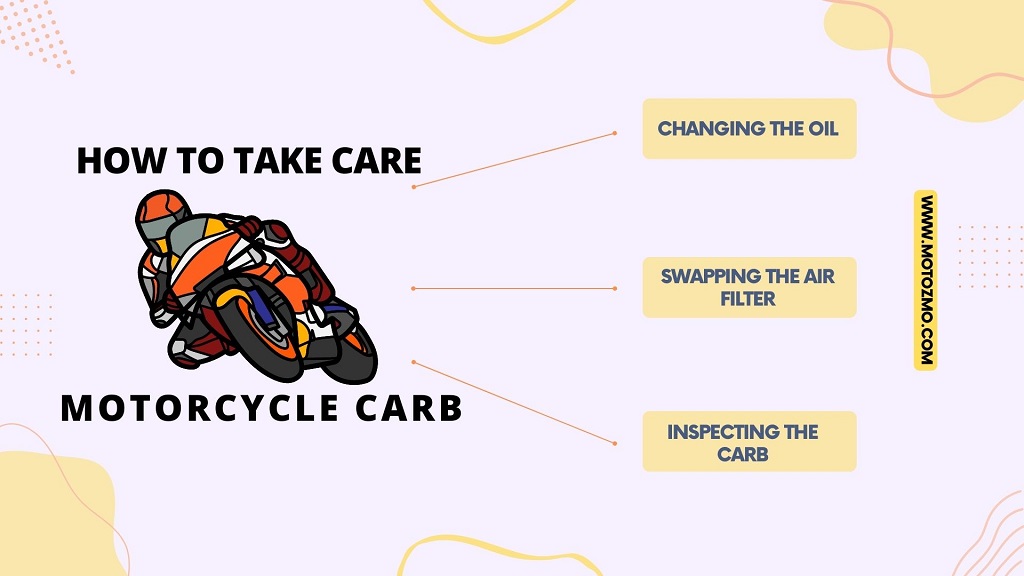
Prefer to watch a tutorial instead? Check this video:
Conclusion
Regular maintenance and cleaning are effective ways to prevent carburetor leaks and keep your motorcycle running well. Following this article’s recommendations, you can reduce the risk of carburetor problems and enjoy your riding experience. If you notice fuel leaking from your carburetor, diagnose and address the issue promptly.
Did you find this guide helpful? Share it with other motorcycle riders who might be facing similar issues!
FAQs About Motorcycle Carb Leaking Gas
Why is my motorcycle carb leaking gas?
A few things can cause carb leaks. It might be a blocked gas cap vent, a stuck float, a worn gasket, or wrong float height. Even tiny cracks in the overflow tube or loose parts like plugs and hoses can make your bike drip fuel.
How can I tell if the gas cap vent is the problem?
Pop open the gas cap and listen. If you hear a hiss, that means the tank had pressure. Cleaning or replacing the vented cap lets the tank breathe properly, often stopping the leak.
What should I check first when my carb leaks?
First, close the petcock and park the bike upright. Next, look and feel along all fuel lines, hoses, and clamps for cracks or drips. Often the cause is outside the carb itself.
Can a stuck float cause a carb to overflow?
Yes. A stuck float keeps the fuel inlet open even when the bowl fills, letting gas spill through overflow. Tap the bowl gently to free it, or carefully clean or replace the float and needle.
What’s wrong with the float height and how do I fix it?
If the float sits too high, the bowl overfills and leaks. Attach clear tubing to the bowl drain to check the fuel level, it should sit 2.5–4.5 mm below the bowl rim. Gently bend the float tab to adjust it.
Could a cracked overflow tube be the leak?
Absolutely. Even small cracks or a loose connection can let fuel escape. Remove the bowl and inspect the tube closely. If you spot damage, replace it or seal it securely with fuel-resistant materials.
Why would a carb leak even after a rebuild?
Sometimes the issue is a stubborn seal, gasket, or float height that wasn’t set right. Or even a loose bowl screw or drain plug. Double-check seals and make sure everything is snug and at the correct spec.

